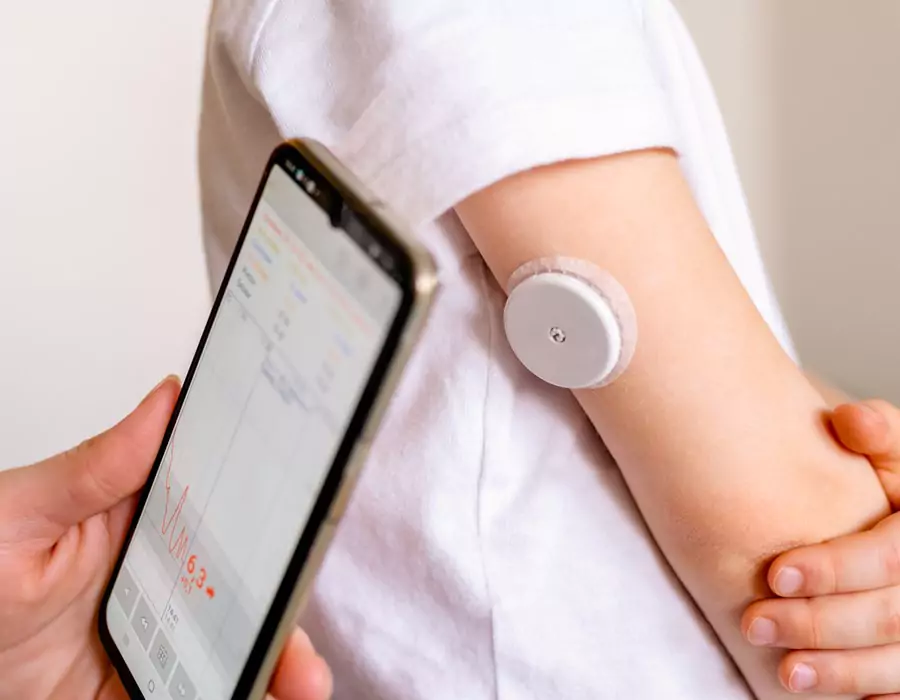





Technology and Diabetes Innovations for Better Management: Dr. Ergin Ahmet


Picture a reality in which living with diabetes has less to do with constant and conscious efforts as much as it is simply living. Transmission that indicates where technology goes hand in hand with innovation to eradicate the difficulties of risk where a change from the impossible to possible is affected. This is the world that Dr. Ergin Ahmet is striving for and that we can achieve through his continuous efforts.
Dr. Ahmet … is one of the leading experts in the sphere of diabetes treatment, and his works have been extremely valuable for the world in general and for people who have to live with diabetes in particular.
And this is the story that is told in this article – the story of the industry of diabetes management technologies, where wonderful inventions are not only ideas but practical tools that improve the lives of millions of people.
Today they discuss the development of diabetes care solutions and the services provided by SugarMDs Meet all of the innovative terrains that are revolutionizing the field of diabetes care today.
The Growth of Diabetes Management
To achieve this, it is important to reminisce about diabetes management over the years to have a basis for comparison. In earlier periods, diabetes was a story of hopelessness and few available choices delivered. Very often, in earlier stages of its development, misdiagnoses were naïve, mainly because people had very poor prognoses and little available therapeutic options. Little did they know how to manage something so fundamental, and they depended on diet and very basic forms of monitoring their condition.
Also, when shifting focus to the present, it is significant to acknowledge that technology has played a massive role in changing the face of diabetes care. What was a minor discovery in the early twentieth century, insulin and what emerged as a technological state in the nineteen sixties blood glucose measuring instrument again brought a new phase of possibilities.
In today’s world, we no longer have a simple tool to help in managing diabetes, rather technology has become the key factor.
New technologies like CGM systems, insulin pumps and application-based methods have changed the level of care from reactive to advanced. These technologies enable people to have more information about diabetes and allow better control of the condition without necessarily adding invasive techniques.
Other alternatives may include this, for example, where CGMs are popular because of their constant glucose level readings that will alert you on your phone when there is a high or low reading. The accuracy in controlling diabetes has increased while people suffering from it have found a better life with the help of these techs.
A new frontier is also being undertaken by integrating artificial intelligence and machine learning in the area of diabetes care. For instance, they make suggestions based on individualized patterns and needs in an effort to personalize treatment.
What if there were a system that learned your daily habits and adjusted insulin doses? That’s not science fiction; it’s diabetes care’s future, which is unfolding right before our very eyes! Dr Ergin Ahmet deserves significant mention in all these advances.
These technologies have come about as a result of his deep knowledge as well as commitment to innovation regarding diabetes. Furthermore, he knows that though medical breakthroughs are vital for improved diabetic management, it is equally important that these innovations be accessible and user-friendly too.
Comprehending Diabetes and Its Implications
Take a moment to pause and really understand diabetes, which affects millions of lives globally. At its core, though it is a disease and has multiple health issues in all facets of life. But what is diabetes? In simple terms, it is when the body either cannot produce enough insulin (type 1 diabetes) or does not respond properly to insulin produced by the pancreas (type 2 diabetes).
Insulin, a hormone that comes from pancreas, plays a very vital role in controlling blood glucose levels. When there is malfunctioning in insulin production, blood sugar builds up leading to complications.
Type 1 diabetes often begins during childhood or adolescence and results from destruction of the insulin-producing cells by autoimmune processes. It’s an incurable condition that necessitates life-long surveillance and treatment through administration of insulin.
In contrast, Type 2 diabetes, the more common form, usually develops in adults and is often linked to lifestyle factors like obesity and physical inactivity. Although modifications to one’s lifestyle may sometimes be all that’s needed for treating type II Diabetes along with drugs prescribed by doctors, monitoring should be done consistently so as to ward off any possible negatives. Gestational diabetes – a temporary ailment occurring during pregnancy is also among them.
Although it typically resolves after delivery, having had gestational diabetes increases a woman’s risk of developing type II Diabetes later on in her child’s life as well as her own. However, only looking at the level of sugar content in blood doesn’t explain enough about complications associated with this global burden known as ‘diabetes’.
According to WHO estimates, about 422 million people worldwide have been diagnosed with this disease since 1980. This staggering increase represents real people dealing every day with issues such as heart attacks, blindness, kidney failure, etcetera. The emotional burden for someone coping with diabetics can be overwhelming, especially if they belong to middle-class families.
Even so, diabetes is not distributed evenly among all populations. It affects low to middle-income countries more than any other where access to basic medicines and health services is usually limited. This inequality is not a mere health issue; it actually amounts to a social and economic problem, which worsens disparities and hampers development.
Diabetes has ramifications that extend beyond individual lives. It has significant implications for national healthcare systems and economies. The global cost of diabetes, including healthcare expenses and lost productivity, is estimated in the hundreds of billions of dollars annually. This financial burden strains healthcare systems, diverts resources from other critical areas and can impede national development.
Nevertheless, amid these difficulties, there is still hope and resilience People living with diabetes are not defined by their condition; they are individuals leading full, active lives.
Changes in treatment options as well as technology, have led to better management of diabetes in many individuals suffering from this condition. There is much going on worldwide to raise awareness about the disease and ensure that people have easy access to medical facilities as well as encourage healthy lifestyles
The importance of figures like Dr. Ergin Ahmet in this situation cannot be over-emphasized. A mastermind in diabetes innovation and care, he understands that the condition is intricate and pervasive. The work of developing and promoting modern diabetes technologies is not just about improving health but an opportunity to improve life for millions facing a worldwide health problem head-on.
In our journey through the universe of diabetes control, we need to keep in mind that behind every statistic or scientific breakthrough lie real human beings who share their stories of struggle, strength and hope. Their experiences propel the search for better treatments, technologies and a future where the impact of diabetes can be minimized, if not outright eliminated.
Diabetes Innovation Breakthroughs
When one delves into the world of diabetes care, it becomes obvious that there exists a landscape humming with creativity as humans strive to survive against all odds. For instance, there have been tremendous advances made over the past few years with regard to managing diabetes which has greatly improved people’s lives living with this condition on daily basis.
Continuous Glucose Monitors
These breakthroughs are not just because of technology but hopeful points, which show the way to simpler and more efficient diabetes management. It is impossible to overemphasize the immense impact of Continuous Glucose Monitors (CGMs) on diabetes management.
They have absolutely transformed how people living with diabetes can track and control their blood sugar levels. CGMs keep monitoring glucose levels all the time, which means that they produce real-time data that give a comprehensive picture of someone’s blood sugar against various factors such as diet, exercise and even stress.
This continuous monitoring allows for more detailed control in order to avoid dangerous highs and lows associated with diabetes. For instance, an individual using CGM can see immediately after eating or engaging in any activity how these activities affected their glucose levels which will enable them to make a well-informed decision concerning what they eat or when they engage in vigorous activities, for instance, doing workouts.
This amount of detail was missing from traditional tests carried out to check blood sugar levels. Furthermore, CGM often comes with alarms indicating too high or low glucose concentration, thus providing additional security.
Insulin Pumps
At the same time, when used together with insulin pumps, the value of CGMs rises again dramatically. Insulin pumps have completely changed the landscape particularly for people who suffer from type 1 diabetes mellitus (T1DM). These small devices worn on the body continuously deliver insulin mimicking natural pancreatic function.
They eliminate the necessity for numerous injections daily, freeing up life for diabetic patients in terms of reducing overall burden, both physical and emotional. Insulin pumps offer precision and flexibility that have improved glycemic control among many patients.
Given this perspective, it becomes possible to derive insulin doses based on real-time information obtained from CGMs so as to suit one’s unique needs at any particular moment. An example would be when Orsted says:
“if my CDM indicates rising blood sugars, I will automatically administer an extra dose of insulin to help prevent the onset of a hyperglycemic episode.” In addition, they have played a significant role in reducing complications associated with diabetes.
These devices maintain good control over blood glucose levels hence preventing other medical conditions that may be caused by prolonged periods of high or low blood sugar, including heart disease, renal problems and nerve damage. The advantages of using insulin pumps for quality of life come into play here.
This used to be hard before but currently, these devices offer better options for this purpose. Their users can participate in activities, eat meals and go about their day without too much worry about how they are managing their diabetes. It is important to remember that people living with diabetes face constant stress and anxiety related to their condition, and anything that reduces this tension has a lot of value.
Artificial Pancreas
The artificial pancreas system, or closed-loop system, has completely changed the way diabetes is treated and transformed into an amazing technology in personalized health care.
For instance, these systems combine continuous glucose monitoring (CGM) gadgets with insulin pumps and use complex AI programs to create synergy that mimics natural functioning of a normal pancreas. By consistently analyzing data on glycemia, they adjust real-time insulin delivery thereby maintain optimum sugar levels with minimum patient effort.
The result is a significant departure from conventional diabetes management approaches to a more automated, precise and less burdensome methodology for managing the disease. These AI-based technologies are transformational tools.
They provide the patient with first-hand experience of how this sophisticated technology can be beneficial, as in the case of the Medtronic 780g insulin pump, which works together with Medtronic Guardian 4 CGM, among others.
This has also resulted in effective control of blood glucose through automation of insulin administration using live information about glucose content hence stabilizing them thus minimizing fluctuations while reducing the incidence of self-injections every now and then or even regular monitoring of blood glucose levels, hence making it easier for someone suffering from diabetic conditions to lead a healthy life every day since it allows them to have no restrictions thus living a healthy life.
Moreover, AI’s impact on predicting blood glucose levels revolutionizes diabetes management. The models designed by AI feed large amounts of real-time sugar data and identify patterns and trends that might not be visible to humans. This results in accurate predictions about the development of blood sugar leading to early interventions meant to prevent hypoglycemia or hyperglycemia.
Such technology relies on personalized prediction algorithms considering individual physiological parameters such as insulin sensitivity, carbohydrate consumption and physical activity when estimating future volumes of sugar values inside their bodies.
All these factors must thus be considered when coming up with an advanced A1C testing method specifically tailored for a better understanding of different aspects affecting one’s blood sugars.
Equally, when integrated into insulin delivery systems AI has improved precision and safety. These algorithms are good at sensing and accounting for the many adjustments in insulin levels due to factors like workouts, stress or disease. This flexibility, coupled with continuous monitoring, significantly reduces complications related to poor glycemic control.
The role of AI in diabetes management is a response to traditional limitations since it offers hope for those who are looking for answers. It may be able to change how diabetes is managed by having an automated insulin delivery system for better managing diabetes and reducing complications.
This shows that diabetes care is undergoing a paradigm shift from being reactive to being proactive toward every implication of this condition.
Telemedicine
Digital health platforms and telehealth have also gained significant ground in the treatment of diabetes, and one person who has played a major role in this field is Dr. Ergin Ahmet. In a world where access to healthcare can be limited, digital platforms break down barriers, providing remote monitoring, personalized coaching as well as data analysis that will optimize the management of diabetes mellitus.
Dr. Ahmet’s work in this area is innovative since it displays how technological advancements can both improve medical outcomes and make healthcare more accessible and patient-centered.
Dr. Ahmet is not only exploiting existing technologies; he instead leads innovation in diabetic care. His job involves combining different technological solutions, which include the use of modern monitoring techniques and treatment approaches driven by data to establish an integrated, user-friendly environment for managing diabetes.
He sees technology as an integral part of everyday life so that people with diabetes may live their lives without any hindrance whatsoever from this condition. There are also smartphone apps and wearables that should not be forgotten when we talk about innovations in diabetology.
These tools have brought diabetes management into the digital age, providing tracking options, reminders as well as educational materials always at hand. Most importantly, these devices promote proactive care while providing critical assistance to both patients with diabetes and medical practitioners serving them.
Knowing all that lets us remember these marvels are not mere gadgets or algorithms, but they represent substantial research work over many years dedicated to understanding what people living with diabetic conditions need.
They empower individuals so that they are able to thrive rather than simply manage their lives with diabetes. At heart, the milestones achieved through innovation on diabetics depict a future where controlling this disease is less burdensome and more intuitive.
Consequently there cannot be too much emphasis on individuals like Dr. Ahmet. Evidently, their tireless search for better, smarter answers continues to move forward the changes seen across diabetic practice hence bringing closer such a world where having it becomes manageable rather than insurmountable.
Why SugarMDs is a Game-Changer in Diabetes Care
SugarMDs stands out as one revolutionary power in the field of diabetes management.
Here’s why:
- Telemedicine and Telehealth Integration: SugarMDs utilizes telemedicine thereby allowing diabetic patients access online consultations together with prescription services. Its unique application enables patient-doctor communication via real-time sharing data on blood sugar levels, medication being taken, mood swings experienced during exercise etc thereby improving disease management.
- Diabetes Management Tailoring: The SugarMDs app aims to address these gaps using an algorithm that collects major influencing factors affecting daily blood glucose fluctuations among patients. For example, it has features like suggested glucose checks, reminders for taking medicine or even immediate transmission of blood sugar diaries to online doctors. Consequently, this allows SugarMDs specialists to give advice concerning diabetes whenever needed as well as prescribe necessary medications instantly rendering diabetes care more reflexive and customized.
- Expert Care Round-the-Clock: Unlike standard telehealth services that operate during business hours only, SugarMDs offers 24/7 access to board-certified endocrinologists and diabetes coaches. It covers evening hours, weekends, and holidays – all the changing requirements associated with living with this condition that ensure that patients receive care when they require it.
- Care Quality and Specialization: Dr Ahmet Ergin, the founder of SugarMDs, maintains that patients should consult with qualified board-certified endocrinologists in specialized fields. The focus on specialized and high quality care is what makes SugarMDs different from other platforms offering generic medical advice.
- Economical Medication Management: SugarMDs works closely with patients through pharmacists to determine the most efficient yet cost-effective prescriptions for diabetes management. As such, this strategy significantly saves them money which is important considering the high cost of original diabetic drugs.
- Emergency Avoidance and Quick Response: The platform has been successful in helping many avoid hospital admissions and ER visits. For example, their instant response to a patient whose blood sugar was above 600 brought down to 150 within hours shows how effective on-demand care can be.
- Insurance Coverage & Reasonable Pricing: Since the outbreak of the recent pandemic, insurance companies, including Medicare, have begun covering telemedicine and online diabetes visits. Such insurances form part of SugarMDs treatment as well as those without any coverage at affordable prices.
- 360-Degree Diabetes Care: In addition to basic telehealth services, SugarMDs offers complete all-around care. Physicians are able to follow patients in real-time with their blood sugar entries while they’re still monitoring overall health anytime using this system. Thus it covers every aspect of diabetes management on demand.
Basically, SugarMDs is a diabetes care game changer because of its technological innovations, personalized caregiving strategies, round-the-clock availability of specialty healthcare, cost-efficient drug administration, rapid emergency services, broad insurance coverage and whole-person treatment approach. This merge makes SugarMDs the best answer from a diabetes care perspective.
Conclusion
When we look back to the world of dynamic diabetes management technology, it appears that the scientific accomplishments made by men like Dr. Ahmet Ergin were more than advancements but hope for many.
The future is presented in terms of manageable diabetes rather than a burden because of possible technological advances and discoveries such as SugarMDs; it is a new stage where diabetic patients are capable of living without thinking about how severe their conditions are.
The road ahead is promising, filled with potential and driven by relentless innovation. It's not about how hard managing diabetes can be but instead what solutions enable a person to live a simpler and healthier life. This future does not seem to be bright, but revolutionarily bright in the hands of technology and under the mind of pioneers such as Dr Ahmet.
References and Resources:
- https://sugarmds.com/online-diabetes-doctor-see-a-doctor-now-via-telehealth/
- https://www.ncbi.nlm.nih.gov/pmc/articles/PMC3749019/
- https://www.ncbi.nlm.nih.gov/pmc/articles/PMC6205949/
- https://www.ncbi.nlm.nih.gov/pmc/articles/PMC2797383/
- https://pubmed.ncbi.nlm.nih.gov/32901098/
- https://pubmed.ncbi.nlm.nih.gov/37592726/
- https://www.ncbi.nlm.nih.gov/pmc/articles/PMC10095542/
About The Author
Meet Dr. Ahmet Ergin a highly skilled and dedicated endocrinologist with a passion for diabetes care. Dr. Ergin earned his medical degree with honors from Marmara University in Istanbul.
He completed internal medicine residency and endocrinology fellowship at Cleveland Clinic. Dr. Ergin is board-certified in Internal Medicine, Endocrinology, Diabetes, and Metabolism due to his vast medical expertise. He's a certified diabetes educator, author of "The Ultimate Diabetes Book," and founder of "the SugarMD YouTube channel."
Dr. Ergin offers exceptional diabetes care to his patients in Port Saint Lucie, FL, helping them manage effectively. Disclaimer: These statements have not been evaluated by the Food and Drug Administration. Information on this website isn’t intended to treat, cure or prevent any disease. Discuss with your doctor and do not self-treat.
Written By Dr. Ahmet Ergin
461 total articles
Meet Dr. Ahmet Ergin, a highly skilled and dedicated endocrinologist with a passion for diabetes care. Dr. Ergin earned his medical degree with honors from Marmara University in Istanbul. He completed internal medicine residency and endocrinology fellowship at Cleveland Clinic. Dr. Ergin is board-certified in Internal Medicine, Endocrinology, Diabetes, and Metabolism due to his vast medical expertise. He's a certified diabetes educator, author of “The Ultimate Diabetes Book,” and founder of “the SugarMD YouTube channel.” Dr. Ergin offers exceptional diabetes care to his patients in Port Saint Lucie, FL, helping them manage effectively. For a closer look into his insights and experiences, connect with Dr. Ahmet Ergin on LinkedIn, Instagram, and YouTube.”
Disclaimer: These statements have not been evaluated by the Food and Drug Administration. Information on this website isn't intended to treat, cure or prevent any disease. Discuss with your doctor and do not self-treat.
Products











